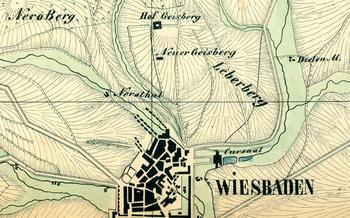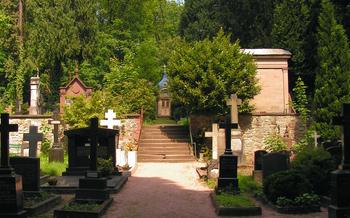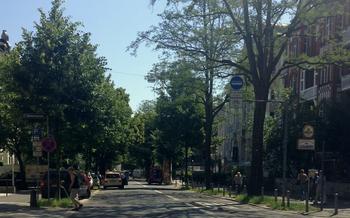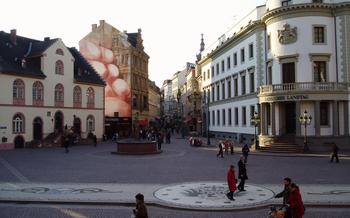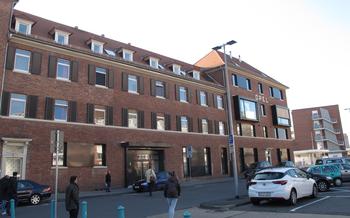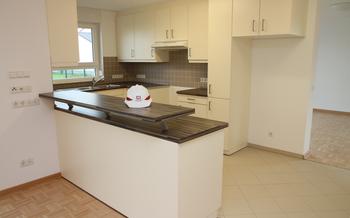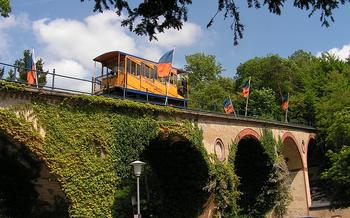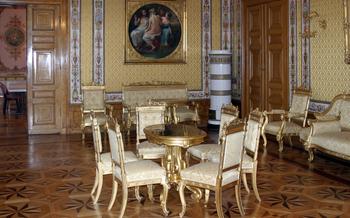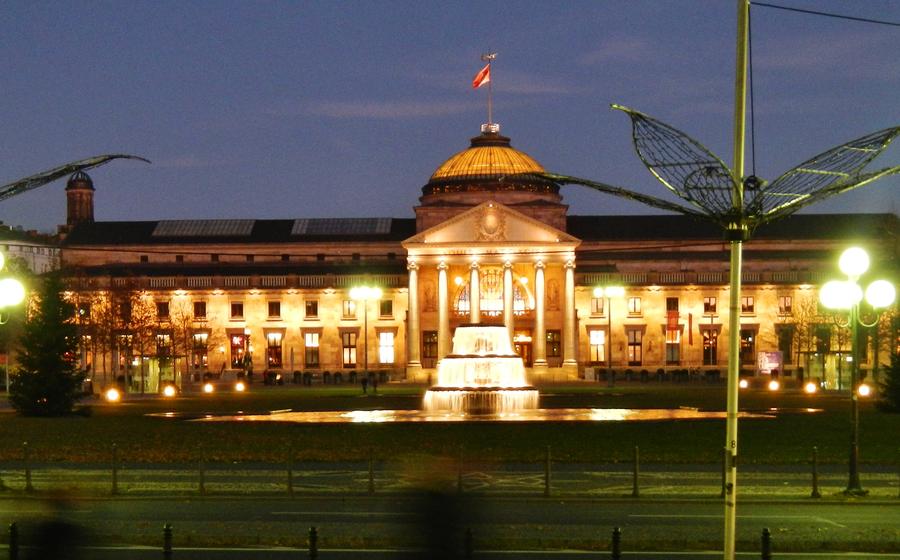
Kurhaus and Casino Wiesbaden
- Kurhaus Wiesbaden
- Casino Wiesbaden
- Kurpark Wiesbaden
- Kochbrunnen
- Kaiser-Friedrich-Bad
- Wiesbaden Museum
- Landesmuseum Wiesbaden
- Stadtschloss Wiesbaden
- Marktkirche Wiesbaden
- History
- Architectural Features
- Interior Highlights
- Guided Tours
- Alter Friedhof Wiesbaden
- Russian Orthodox Church
- Biebricher Schloss
- Insider Tip
Kurhaus Wiesbaden
The Kurhaus Wiesbaden is a world-renowned landmark and symbol of the city. Completed in 1907, it was designed by Friedrich von Thiersch in an opulent Neo-Baroque style. The building's exterior is adorned with intricate carvings, sculptures, and a grand portico supported by massive columns. Inside, visitors are greeted by a magnificent entrance hall, a grand ballroom, and numerous elegant function rooms. The Kurhaus has hosted countless prestigious events throughout its history, including concerts by renowned musicians, lavish balls, and international conferences. Today, it continues to be a popular venue for weddings, galas, and other special occasions.
Casino Wiesbaden
The history of the Casino Wiesbaden is intertwined with the development of the city as a spa town. In the early 19th century, Wiesbaden's reputation as a health resort grew, attracting wealthy visitors from all over Europe. To cater to these visitors, a casino was opened in 1810, initially located in the Kurhaus.
Over the years, the casino grew in popularity and size, requiring a larger space. In 1872, a new casino building was constructed, designed by the renowned architect Christian Zais. This magnificent building, with its grand facade and elegant interior, quickly became one of the most popular casinos in Europe.
The Casino Wiesbaden offers a wide variety of games, including roulette, blackjack, baccarat, and poker. It is also known for its strict dress code, which requires guests to dress formally. In addition, the casino has a number of restaurants and bars, as well as a theater and a concert hall.
The Casino Wiesbaden is a popular destination for both tourists and locals. It is a place to see and be seen, to gamble and to enjoy a night out. Whether you are a high roller or just looking for a fun evening, the Casino Wiesbaden is sure to provide a memorable experience.
Kurpark Wiesbaden
The Kurpark Wiesbaden is a beautiful and historic park located in the heart of the city. It was created in the early 19th century as a place for visitors to relax and enjoy the healing waters of the city's thermal springs. The park is home to a variety of attractions, including a rose garden, a bandstand, a playground, and a number of sculptures and fountains.
One of the most notable features of the Kurpark is the Wandelhalle, a long, colonnaded walkway that runs through the center of the park. The Wandelhalle was built in the 1840s and is a popular spot for visitors to stroll and admire the views of the park. The Wandelhalle is also home to a number of cafes and restaurants, making it a great place to stop for a bite to eat or a drink.
The Kurpark is also a popular place for events and activities. In the summer, the park hosts a number of concerts and festivals. In the winter, the park is transformed into a winter wonderland, with ice skating, sleigh rides, and other winter activities.
If you are looking for a place to relax and enjoy the outdoors, the Kurpark Wiesbaden is the perfect place to visit. The park is open to the public free of charge and is a great place to spend an afternoon or evening.
Kochbrunnen
The Kochbrunnen, or "boiling spring" is one of Wiesbaden's most famous landmarks. It is a natural hot spring that has been used for its healing properties since Roman times. The spring's water is rich in minerals, including sodium chloride, calcium, and magnesium. It has been shown to have a number of health benefits, including reducing inflammation, improving digestion, and boosting the immune system.
The Kochbrunnen is located in the heart of Wiesbaden, on the Kurhausplatz. It is housed in a beautiful building that was constructed in 190The building features a large dome and a number of ornate decorations. The spring's water is dispensed from a number of taps that are located inside the building.
Visitors to Wiesbaden can enjoy the healing properties of the Kochbrunnen water by drinking it or by taking a bath in it. There is a drinking hall located next to the spring where visitors can drink the water for free. There is also a number of spas in Wiesbaden that offer baths in the spring's water.
The Kochbrunnen is a popular tourist destination. It is a great place to relax and enjoy the city's beautiful architecture. The spring's water is also known for its health benefits, making it a great place to improve your overall well-being.
Kaiser-Friedrich-Bad
The Kaiser-Friedrich-Bad is a historic bathhouse in Wiesbaden, Germany. It was built in the late 19th century and is one of the most famous thermal baths in Europe. The bathhouse is named after Kaiser Friedrich III, who was a frequent visitor.
The Kaiser-Friedrich-Bad is a beautiful example of Neo-Renaissance architecture. It is made of red sandstone and has a grand entrance with a large portico. The interior of the bathhouse is just as impressive, with its marble floors, stained glass windows, and vaulted ceilings.
The Kaiser-Friedrich-Bad offers a variety of thermal baths, as well as other spa treatments. The thermal waters are said to have healing properties, and the bathhouse is a popular destination for people with rheumatism, arthritis, and other ailments.
The Kaiser-Friedrich-Bad is a must-visit for anyone interested in history, architecture, or wellness. It is a beautiful and relaxing place to spend a few hours or even a whole day.
Services offered
The Kaiser-Friedrich-Bad offers a variety of services, including:
- Thermal baths
- Massage
- Sauna
- Steam room
- Solarium
- Fitness center
- Hair salon
- Beauty salon
Thermal waters
The thermal waters at the Kaiser-Friedrich-Bad are rich in minerals, including calcium, magnesium, and sodium. The waters are said to have healing properties, and the bathhouse is a popular destination for people with rheumatism, arthritis, and other ailments.
The thermal waters are also used in the bathhouse's spa treatments. These treatments include massages, facials, and body wraps. The spa treatments are designed to help people relax and rejuvenate.
The Kaiser-Friedrich-Bad is a beautiful and relaxing place to spend a few hours or even a whole day. It is a must-visit for anyone interested in history, architecture, or wellness.
Wiesbaden Museum
The Wiesbaden Museum, established in 1825, is a treasure trove of cultural and historical artifacts that narrate the captivating story of Wiesbaden's rich past. Housed in a striking Neoclassical building, this museum takes visitors on a journey through time, showcasing a diverse collection of exhibits that span from prehistoric times to the present day.
The museum's collection boasts an impressive array of archaeological finds, providing a glimpse into the region's earliest settlements. Visitors can marvel at Stone Age tools, Bronze Age weapons, and Roman artifacts, gaining insights into the lives and customs of Wiesbaden's ancient inhabitants.
Among the highlights of the Wiesbaden Museum is its collection of paintings and sculptures, featuring works by renowned artists from various periods. From medieval altarpieces to Baroque masterpieces, the museum's art collection offers a visual feast for art enthusiasts. Notable works include paintings by Lucas Cranach the Elder, Hans Holbein the Younger, and Peter Paul Rubens, as well as sculptures by Tilman Riemenschneider and Ignaz Günther.
In addition to its permanent collection, the Wiesbaden Museum frequently hosts temporary exhibitions, showcasing a diverse range of themes and topics. These exhibitions often feature works from international artists and institutions, providing visitors with a chance to experience new perspectives and explore different cultures.
Landesmuseum Wiesbaden
The Landesmuseum Wiesbaden finds its home within the former palace of the Dukes of Nassau and was established in 1820. The museum's impressive collection encompasses an array of artifacts, spanning from prehistoric times to the present day. Among its highlights are the collections of Roman antiquities, which include sculptures, mosaics, and inscriptions from the region.
The museum also boasts a comprehensive collection of European paintings from the 14th to the 20th century, showcasing the works of renowned artists such as Cranach, Rembrandt, and Monet. Of particular note is the collection of works by the Expressionist painter Franz Marc, one of the founding members of the influential German Expressionist group Der Blaue Reiter.
In addition to its extensive art collection, the Landesmuseum Wiesbaden houses a collection of natural history specimens, including fossils, minerals, and taxidermied animals. These exhibits provide insights into the region's rich natural heritage, from the Ice Age to the present day.
Temporary exhibitions are frequently held at the museum, showcasing a diverse range of topics and shedding light on various aspects of art, history, and culture. These exhibitions provide visitors with an opportunity to delve deeper into specific themes and discover new perspectives.
Stadtschloss Wiesbaden
The Stadtschloss Wiesbaden is a magnificent palace located in the heart of Wiesbaden, Germany. It was built between 1837 and 1841 in the Neoclassical style and served as the residence of the Dukes of Nassau. The palace is known for its impressive architecture, elegant interiors, and rich history.
The Stadtschloss Wiesbaden was designed by Georg Moller, a renowned German architect. It features a grand facade with Corinthian columns, a triangular pediment, and intricate sculptures. The interior of the palace is equally impressive, with its grand staircase, opulent reception rooms, and exquisite furnishings.
The Stadtschloss Wiesbaden was the official residence of the Dukes of Nassau until 1866, when the duchy was annexed by Prussia. After the annexation, the palace became the official residence of the Prussian governors of Wiesbaden. In 1945, the palace was damaged during an air raid, but it was later restored to its former glory.
Today, the Stadtschloss Wiesbaden is used for a variety of purposes. It houses the Hessian State Parliament, the Hessian Ministry of Finance, and the Wiesbaden City Hall. The palace is also used for official receptions, conferences, and other events.
Visitors to the Stadtschloss Wiesbaden can take a guided tour to learn about the history of the palace and to see its impressive architecture and interiors. The palace is also a popular venue for weddings and other special events.
Marktkirche Wiesbaden
The Marktkirche Wiesbaden, also known as the Church of Our Lady, is a Protestant church located in the center of Wiesbaden, Germany. It is considered one of the most important Gothic churches in the Rhine-Main region.
History
The Marktkirche was built between 1344 and 1521 on the site of an earlier Romanesque church. The church was badly damaged in a fire in 1853 but was subsequently rebuilt. During World War II, the church was again damaged by bombing, but it was once again rebuilt and reopened in 195
Architectural Features
The Marktkirche is a large, imposing church with a distinctive red sandstone exterior. The church's most striking feature is its tall, slender spire, which rises to a height of 65 meters. The church's interior is spacious and bright, with a nave that is lined with tall, pointed arches. The church also features a number of beautiful stained glass windows, which depict scenes from the Bible.
Interior Highlights
The Marktkirche is home to a number of important works of art, including a 15th-century altarpiece by Hans Holbein the Younger. The church also features a number of impressive sculptures, including a bronze statue of Martin Luther by Ludwig Schwanthaler.
Guided Tours
The Marktkirche offers guided tours in German and English. Tours last approximately 45 minutes and cover the history, architecture, and art of the church.
Alter Friedhof Wiesbaden
History of the Cemetery
The Alter Friedhof Wiesbaden, or Old Cemetery of Wiesbaden, is a historic burial ground located in the center of the city. It was established in 1800 and served as the main cemetery for Wiesbaden until 187The cemetery is a testament to the city's rich history and features a diverse collection of tombs and monuments.
Notable Burials
The Alter Friedhof is the resting place of many notable figures from Wiesbaden's past. Among them are:
- Wilhelm Conrad Röntgen, the discoverer of X-rays.
- Friedrich Wilhelm Schultz, a prominent German architect.
- Friedrich Wilhelm von Bismarck, the first Chancellor of Germany.
- Prince Adolf of Nassau, the last Duke of Nassau.
Notable Monuments
The Alter Friedhof is also home to a number of notable monuments. These include:
- The Soldiers' Memorial, which commemorates the soldiers who died in the Franco-Prussian War.
- The Bismarck Monument, which honors the life and achievements of Otto von Bismarck.
- The Röntgengedenkstein, a monument to Wilhelm Conrad Röntgen, the discoverer of X-rays.
Guided Tours
Guided tours of the Alter Friedhof are available from the Wiesbaden Tourist Information Office. These tours provide an opportunity to learn more about the history of the cemetery and the notable figures buried there.
Russian Orthodox Church
A breathtaking landmark nestled in the heart of Wiesbaden, the Russian Orthodox Church, also known as the St. Elizabeth's Church, stands as a testament to the rich cultural heritage of the city. Its genesis can be traced back to the 1840s when the Russian aristocracy sought a sacred space for Orthodox worship during their frequent visits to the spa town. With the generous patronage of the Russian imperial family, the church's construction commenced in 1847 under the guidance of renowned architect Philipp Hoffmann.
The architectural style of the church is a harmonious blend of Byzantine and Romanesque influences, featuring five gilded domes that gleam against the backdrop of the Wiesbaden skyline. Its ornate facade captivates visitors with intricate carvings, delicate moldings, and a mesmerizing array of colorful tiles. The interior of the church is equally awe-inspiring, adorned with opulent frescoes, intricate iconography, and a resplendent iconostasis that separates the sanctuary from the nave.
Beyond its architectural grandeur, the Russian Orthodox Church holds immense spiritual significance for the Russian community in Wiesbaden. It serves as a venue for regular religious services, attracting devout worshippers from across the region. The church also hosts cultural events, concerts, and exhibitions that showcase the vibrant traditions of Russian Orthodoxy.
Guided tours are available for those who wish to delve deeper into the history, architecture, and religious significance of the Russian Orthodox Church. Knowledgeable guides provide fascinating insights into the church's origins, its unique features, and the role it has played in the cultural landscape of Wiesbaden. Visitors are encouraged to immerse themselves in the serene atmosphere of the church, marvel at its exquisite artistry, and gain a profound appreciation for the enduring legacy of Russian culture in the city.
Biebricher Schloss
The Biebricher Schloss is a magnificent palace located in the Biebrich district of Wiesbaden, on the banks of the Rhine River. It was built in the 18th century as a summer residence for the Prince-Bishops of Mainz and is one of the most significant Baroque palaces in Germany.
The palace was designed by the renowned architect Johann Kaspar Herwarthel, and its construction was completed in 1750. It features a grand main building with two wings, an impressive entrance hall, and a beautiful park with fountains and sculptures. The interior of the palace is lavishly decorated with frescoes, stucco work, and tapestries, and it houses a collection of valuable paintings and furniture.
Today, the Biebricher Schloss is owned by the state of Hesse and is used for official events and receptions. It is also open to the public for guided tours, which allow visitors to explore the grand halls, admire the exquisite artwork, and learn about the rich history of the palace.
A visit to the Biebricher Schloss is a must for anyone interested in history, architecture, or art. It offers a glimpse into the opulent lifestyle of the Prince-Bishops of Mainz and is a testament to the grandeur of the Baroque era.
Insider Tip
Best time to visit Wiesbaden: The best time to visit Wiesbaden is during the warmer months, from May to September, when the weather is pleasant and the parks and gardens are in full bloom.
Tips for saving money: Take advantage of the Wiesbaden Card, which offers free admission to many of the city's attractions and discounts on other activities. Consider purchasing a multi-day pass for public transportation, which will allow you to get around the city easily and affordably.
Getting around the city: Wiesbaden is a very walkable city, and many of the main attractions are located within easy walking distance of each other. However, if you do need to take public transportation, the city's bus and tram system is efficient and affordable.
Must-try local foods: Wiesbaden is home to a number of culinary delights, including the famous "Handkäs mit Musik" (a type of cheese served with onions and vinegar), "Spundekäs" (a cheese spread made with beer), and "Grüne Soße" (a green sauce made with seven herbs).
